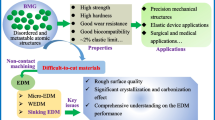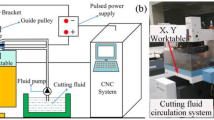Abstract
Bulk metallic glass composites (BMGCs) have good combination of mechanical properties when compared with monolithic bulk metallic glasses (BMGs) and conventional crystalline alloys. However, with high strength, high hardness and metastable atomic structures, BMGCs are classified as difficult-to-cut materials, and how to process BMGCs is important before their engineering applications. In this work, die-sinking electrical discharge machining (EDM) of BMGCs was conducted, and compared with conventional industrial pure Zr (Zr702), under both rough and refined conditions. The EDM performance, including material removal rate (MRR), surface roughness, surface morphology, element variation, and crystallization, was investigated. The findings have shown that the peak current contributed most to the variation of MRR and surface roughness of BMGCs, followed by pulse-on time. BMGC workpiece material was more easily removed by sparking than Zr702 due to the relatively lower melting point and smaller thermal conductivity. During sparking, the melted BMGC workpiece material tends to have smaller viscosity and larger explosive forces, resulting in larger craters, corrugated ridges, and resultant higher surface roughness. Nevertheless, good surface quality with low surface roughness comparable to conventional Zr702 was also obtained for BMGCs under refined conditions. After EDM, the composite microstructure of BMGCs changed to amorphous matrix and ZrC/TiC carbides for ZrCu-based and TiCu-based BMGCs, respectively. The mechanisms for the change of atomic structures in BMGCs during die-sinking EDM were discussed, and the findings have shown that the carbonization effect can be reduced or even eliminated by optimizing the processing parameters. Finally, strategies for achieving better die-sinking EDM performance of BMGCs were proposed.




















Similar content being viewed by others
Availability of data and material
The raw/processed data will be made available on request.
Code availability
Not applicable.
References
Qiao JW, Jia HL, Liaw PK (2016) Metallic glass matrix composites. Mater Sci Eng R 100:1–69. https://doi.org/10.1016/j.mser.2015.12.001
Kumar G, Desai A, Schroers J (2011) Bulk metallic glass: the smaller the better. Adv Mater 23:461–476. https://doi.org/10.1002/adma.201002148
Jiang JZ, Hofmann D, Jarvis DJ, Fecht HJ (2015) Low-density high-strength bulk metallic glasses and their composites: a review. Adv Eng Mater 17:761–780. https://doi.org/10.1002/adem.201400252
Wu H, Liang LX, Lan XD, Yin Y, Song M, Li RD, Liu Y, Yang HO, Liu L, Cai AH, Li QX, Huang WD (2020) Tribological and biological behaviors of laser cladded Ti-based metallic glass composite coatings. Appl Surf Sci 507:145104. https://doi.org/10.1016/j.apsusc.2019.145104
Chen SH, Ge Q, Zhang JS, Chang WJ, Zhang JC, Tang HH, Yang HD (2021) Low-speed machining of a Zr-based bulk metallic glass. J Manuf Process 72:565–581. https://doi.org/10.1016/j.jmapro.2021.10.055
Nair S, Dutta A, Narayanan R, Giridharan A (2019) Investigation on EDM machining of Ti6Al4V with negative polarity brass electrode. Mater Manuf Process 34:1824–1831. https://doi.org/10.1080/10426914.2019.1675891
Sharma V, Patel DS, Jain VK, Ramkumar J (2020) Wire electrochemical micromachining: an overview. Int J Mach Tools Manuf 155:103579. https://doi.org/10.1016/j.ijmachtools.2020.103579
Chen XH, Zhang XC, Zhang Y, Chen GL (2008) Fabrication and characterization of metallic glasses with a specific microstructure for micro-electro-mechanical system applications. J Non-Cryst Solids 345:3308–3316. https://doi.org/10.1016/j.jnoncrysol.2008.01.030
Chen SH, Chan KC, Xia L (2014) Deformation behavior of bulk metallic glass structural elements. Mater Sci Eng A 606:196–204. https://doi.org/10.1016/j.msea.2014.03.094
Zhang B, Fu HM, Li ZK, Zhu ZW, Zhang HF, Hu ZQ (2014) Anisotropic tensile properties of tungsten fiber reinforced Zr based metallic glass composites. Mater Sci Eng A 619:165–170. https://doi.org/10.1016/j.msea.2014.09.084
Chen SH, Li C, Zhang JS, Qin YQ, Yang HD, Zhang JC, Chang WJ, Tang HH, Wu YC (2021) On the relationship between the accumulation and release of elastic energy during the flow serrations of a Zr-based bulk metallic glass. Mater Sci Eng A 817:141423. https://doi.org/10.1016/j.msea.2021.141423
Xu JK, Pei QQ, Lian ZX, Yu P, Ma GS, Yu HD (2019) Experimental study on wire-electrical discharge machining of zirconium-based metallic glass. Mater Res Express 6:115214. https://doi.org/10.1088/2053-1591/ab2773
Huang ZY, Liang X, Chang CT, Ma J (2019) WEDM-LS processing sophisticated and durable Zr-based metallic glass mold insert for micro structure injection of polymers. Biomed Microdevices 21:13. https://doi.org/10.1007/s10544-019-0366-0
Chang WJ, Li XX, Yang HD, Zhang JS, Zhang JC, Tang HH, Chen SH (2022) On the wire EDM of metastable atomic structured bulk metallic glasses. Int J Adv Manuf Technol. https://doi.org/10.1007/s00170-022-09068-5
Yeo SH, Tan PC, Aligiri E, Tor SB, Loh NH (2009) Processing of Zirconium-based bulk metallic glass (BMG) using micro electrical discharge machining (Micro-EDM). Mater Manuf Process 24:1242–1248. https://doi.org/10.1080/10426910903129661
Xu B, Wu XY, Ma J, Liang X, Lei JG, Wu B, Ruan SC, Wang ZL (2016) Micro-electrical discharge machining of 3D micro-molds from Pd40Cu30P20Ni10 metallic glass by using laminated 3D micro-electrodes. J Micromech Microeng 26:035004. https://doi.org/10.1088/0960-1317/26/3/035004
Huang H, Yan JW (2015) On the surface characteristics of a Zr-based bulk metallic glass processed by microelectrical discharge machining. Appl Surf Sci 355:1306–1315. https://doi.org/10.1016/j.apsusc.2015.08.239
Huang H, Yan JW (2016) Microstructural changes of Zr-based metallic glass during microelectrical discharge machining and grinding by a sintered diamond tool. J Alloys Compd 688:14–21. https://doi.org/10.1016/j.jallcom.2016.07.181
Liu C, Duong N, Jahan MP, Ma J, Kirwin R (2019) Experimental investigation and numerical simulation of micro-EDM of bulk metallic glass with focus on crater sizes. Procedia Manuf 34:275–286. https://doi.org/10.1016/j.promfg.2019.06.151
Tsui HP, Hsu SY (2022) Study on Fe-based metallic glass micro hole machining by using micro-EDM combined with electrophoretic deposition polishing. Processes 10:96. https://doi.org/10.3390/pr10010096
Kuriakose S, Patowari PK, Bhatt J (2020) Effect of micro-EDM machining parameters on the accuracy of micro hole drilling in Zr-based metallic glass. Eng Res Express 2:015001. https://doi.org/10.1088/2631-8695/ab5c72
Hsieh SF, Chen SL, Lin MH, Ou SF, Lin WT, Huang MS (2013) Crystallization and carbonization of an electrical discharge machined Zr-based bulk metallic glass alloy. J Mater Res 28:3177–3184. https://doi.org/10.1557/jmr.2013.329
Pradana YRA, Ferara A, Aminnudin A, Wahono W, Jang JSC (2020) The effect of discharge current and pulse-on time on biocompatible Zr-based BMG sinking-EDM. Open Eng 10:401–407. https://doi.org/10.1515/eng-2020-0049
Zuo L, Pang SJ, Zou SF, Li HF, Zhang T (2017) Surface vitrification of alloys by pulsed electrical discharge treatment. J Alloys Compd 707:148–154. https://doi.org/10.1016/j.jallcom.2016.12.312
Dai H, Sun J, Li ZT, Zhao JF, Yu XX, Fang HJ, Chen JH (2018) Fabrication of metallic glass layers on Al alloys with improved corrosion resistance and micro-hardness by pulsed electrical discharge treatment. Appl Sci 8:956. https://doi.org/10.3390/app8060956
Salvati E, Korsunsky AM (2020) Micro-scale measurement & FEM modelling of residual stresses in AA6082-T6 Al alloy generated by wire EDM cutting. J Mater Process Tech 275:116373. https://doi.org/10.1016/j.jmatprotec.2019.116373
Chen SH, Chan KC, Xia L (2015) Fracture morphologies of Zr-based bulk metallic glasses under different stress states. Adv Eng Mater 17:366–373. https://doi.org/10.1002/adem.201300426
Zuo L, Li X, Zhang K, Zhang T (2021) General route to fabricate ultrafine metallic glass powders directly from their own crystalline states by localized pulsed electrical discharge atomization. Intermetallics 136. https://doi.org/10.1016/j.intermet.2021.107267
Chen SH, Cheng HY, Chan KC, Wang G (2018) Metallic glass structures for mechanical-energy-dissipation purpose: a review. Metals 8:689. https://doi.org/10.3390/met8090689
Chen SH, Chan KC, Han DX, Zhao L, Wu FF (2019) Programmable super elastic kirigami metallic glasses. Mater Design 169:107687. https://doi.org/10.1016/j.matdes.2019.107687
Funding
The work described in this paper was supported by grants from the National Natural Science Foundation of China under research project no. 51801049, and the Fundamental Research Funds for the Central Universities (grant no. JZ2022HGTB0247).
Author information
Authors and Affiliations
Contributions
Shunhua Chen designed and supervised work. Material preparation, experiments, and data collection were performed by Kangkang Feng and Hewei Gu. The first draft of the manuscript was written by Hewei Gu, Kangkang Feng, and Shunhua Chen. All authors contributed to the data analysis and discussion, and approved the final manuscript.
Corresponding author
Ethics declarations
Ethics approval
Not applicable.
Consent to participate
Not applicable.
Consent for publication
The authors agreed with the submission of this manuscript to the journal.
Competing interests
The authors declare no competing interests.
Additional information
Publisher's Note
Springer Nature remains neutral with regard to jurisdictional claims in published maps and institutional affiliations.
Supplementary Information
Below is the link to the electronic supplementary material.
Rights and permissions
About this article
Cite this article
Chen, S., Gu, H., Feng, K. et al. A comparative study on the die-sinking EDM performance of bulk metallic glass composites under rough and refined conditions. Int J Adv Manuf Technol 121, 4865–4883 (2022). https://doi.org/10.1007/s00170-022-09635-w
Received:
Accepted:
Published:
Issue Date:
DOI: https://doi.org/10.1007/s00170-022-09635-w




